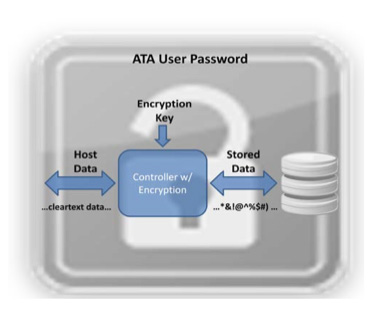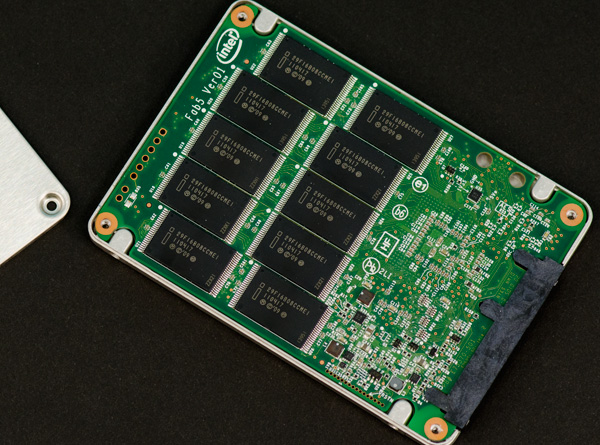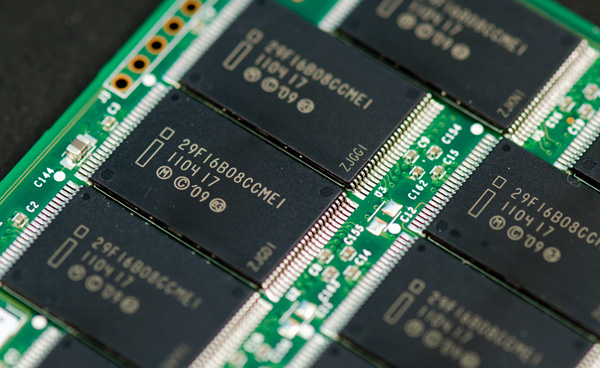The Intel SSD 320 Review: 25nm G3 is Finally Here
by Anand Lal Shimpi on March 28, 2011 11:08 AM EST- Posted in
- IT Computing
- Storage
- SSDs
- Intel
- Intel SSD 320
Spare Area and Redundant NAND
Intel's controller is a 10-channel architecture and thus drive capacities are still a little wonky compared to the competition. Thanks to 25nm NAND we now have some larger capacities to talk about: 300GB and 600GB.
Intel sent a 300GB version of the 320 for us to take a look at. Internally the drive has 20 physical NAND devices. Each NAND device is 16GB in size and features two 64Gbit 25nm 2-bit MLC NAND die. That works out to be 320GB of NAND for a drive whose rated capacity is 300GB. In Windows you'll see ~279GB of free space, which leaves 12.8% of the total NAND capacity as spare area.
Around half of that spare area is used to keep write amplification low and for wear leveling, both typical uses of spare area. The other half is for surplus NAND arrays, a RAID-like redundancy that Intel is introducing with the SSD 320.
As SandForce realized in the development of its controller, smaller geometry NAND is more prone to failure. We've seen this with the hefty reduction in rated program/erase cycles since the introduction of 50nm NAND. As a result, wear leveling algorithms are very important. With higher densities however comes the risk of huge amounts of data loss should there be a failure in a single NAND die. SandForce combats the problem by striping parity data across all of the NAND in the SSD array, allowing the recovery of up to a full NAND die should a failure take place. Intel's surplus NAND arrays work in a similar manner.
Instead of striping parity data across all NAND devices in the drive, Intel creates a RAID-4 style system. Parity bits for each write are generated and stored in the remaining half of the spare area in the SSD 320's NAND array. There's more than a full NAND die (~20GB on the 300GB drive) worth of parity data on the 320 so it can actually deal with a failure of more than a single 64Gbit (8GB) die.
Sequential Write Cap Gone, but no 6Gbps
The one thing that plagued Intel's X25-M was its limited sequential write performance. While we could make an exception for the G1, near the end of the G2's reign as most-recommended-drive the 100MB/s max sequential write speed started being a burden(especially as competing drives caught up and surpassed its random performance). The 320 fixes that by increasing rated sequential write speed to as high as 220MB/s.
You may remember that with the move to 25nm Intel also increased page size from 4KB to 8KB. On the 320, Intel gives credit to the 8KB page size as a big part of what helped it overcome its sequential write speed limitations. With twice as much data coming in per page read it's possible to have a fully page based mapping system and still increase sequential throughput.
Given that the controller hasn't changed since 2009, the 320 doesn't support 6Gbps SATA. We'll see this limitation manifest itself as a significantly reduced sequential read/write speed in the benchmark section later.
AES-128 Encryption
SandForce introduced full disk encryption starting in 2010 with its SF-1200/SF-1500 controllers. On SandForce drives all data written to NAND is stored in an encrypted form. This encryption only protects you if someone manages to desolder the NAND from your SSD and probes it directly. If you want your drive to remain for your eyes only you'll need to set an ATA password, which on PCs is forced by setting a BIOS password. Do this on a SandForce drive and try to move it to another machine and you'll be faced with an unreadable drive. Your data is already encrypted at line speed and it's only accessible via the ATA password you set.

Intel's SSD 320 enables a similar encryption engine. By default all writes the controller commits to NAND are encrypted using AES-128. The encryption process happens in realtime and doesn't pose a bottleneck to the SSD's performance.
The 320 ships with a 128-bit AES key from the factory, however a new key is randomly generated every time you secure erase the drive. To further secure the drive the BIOS/ATA password method I described above works as well.
A side effect of having all data encrypted on the NAND is that secure erases happen much quicker. You can secure erase a SF drive in under 3 seconds as the controller just throws away the encryption key and generates a new one. Intel's SSD 320 takes a bit longer but it's still very quick at roughly 30 seconds to complete a secure erase on a 300GB drive. Intel is likely also just deleting the encryption key and generating a new one. Without the encryption key, the data stored in the NAND array is meaningless.
The Test
| CPU |
Intel Core i7 965 running at 3.2GHz (Turbo & EIST Disabled) Intel Core i7 2600K running at 3.4GHz (Turbo & EIST Disabled) - for AT SB 2011, AS SSD & ATTO |
| Motherboard: |
Intel DX58SO (Intel X58) Intel H67 Motherboard |
| Chipset: |
Intel X58 + Marvell SATA 6Gbps PCIe Intel H67 |
| Chipset Drivers: |
Intel 9.1.1.1015 + Intel IMSM 8.9 Intel 9.1.1.1015 + Intel RST 10.2 |
| Memory: | Qimonda DDR3-1333 4 x 1GB (7-7-7-20) |
| Video Card: | eVGA GeForce GTX 285 |
| Video Drivers: | NVIDIA ForceWare 190.38 64-bit |
| Desktop Resolution: | 1920 x 1200 |
| OS: | Windows 7 x64 |













194 Comments
View All Comments
Chloiber - Tuesday, March 29, 2011 - link
True.It is true, thet the REAL capacity of flash drives is 2 based. The NAND chips are.
So a 120GB drive has in reality 128GB of flash.
So its 120/128 % spare area. The 300GB version has also 300/320 % spare area (which is exactly the same).
Anand is confusing things. The user gets 300GB, as he gets 300GB when buying a HDD. Windows on the other han is showing us "GiB" not "GB". But it's not a real difference in size. 74.5GiB EQUALS 80GB. It's the same thing. Compare the BYTE numbers if you wanna be sure, not the KB/MB/GB/TB numbers.
I'm actually shocked that this still gets confused.
overzealot - Tuesday, March 29, 2011 - link
RAM was not the only thing that was calculated using binary pseudo-metric prefixes. Perhaps you aren't old enough to remember the days before kibibytes, when all computer disks and tapes were measured as such.noblemo - Wednesday, April 6, 2011 - link
Conversion from GB to GiB:320 / 1.024^3 = 298 GiB
Subtract 6.25% spare area:
298 x (1-0.0625) = 279 GiB
MeanBruce - Monday, March 28, 2011 - link
You can blather all the technostats you want 25nm, who cares, didn't change a thing! My next ssd, would never have said this a year ago, looks like Corsair Force GT! Read/Write 500/500 is all you need to say!;)zanon - Monday, March 28, 2011 - link
Granted, this isn't a stunning offering. But one thing I do look forward to is that I think we will finally start to see updated filesystems start to appear in the near future. For example, ZFS appears as if it will at last appear as a full Mac OS X file system via Z-410 this summer.One of the features of modern filesystems is full filesystem level compression and encryption (which really is where such features belong). I will be looking forward to (hopefully) seeing you test how this affects the SSD scene. My principle concern with Sandforce's strategy in the back of my head has always been this: that sooner or later, OS makers or someone will finally get with it and make full compression standard in the FS. At that point, the "worst case" scenario of fully random data will become the *only* scenario. That still leaves a (huge huge) legacy market, and likely time to adapt, but I do wonder if it will shake up the SSD scene at all once again.
overzealot - Tuesday, March 29, 2011 - link
I don't agree. If the controllers are powerful enough to do encryption and compression in real-time, then it should still be done at the disk level.You can still encrypt/compress in your OS as you please, but I like having performance.
PS, not dogging on ZFS, I use it all the time with openindiana.
marc1000 - Monday, March 28, 2011 - link
vertex 3 is not already on market???http://www.amazon.com/OCZ-Technology-Vertex-2-5-In...
aork - Monday, March 28, 2011 - link
That's for pre-order. Notice "Usually ships within 1 to 2 months."piquadrat - Monday, March 28, 2011 - link
Is it sufficient, security wise, using only max. 8 characters ATA password against thieves?One program, I sometimes use, MHDD offers ATA password reset option.
If someone can bypass ATA pass so easily what all this AES128 is for?
Could someone explain this matter to me?
DesktopMan - Monday, March 28, 2011 - link
The password is used to generate the encryption key, much like how software products such as TrueCrypt does it.The max length of ata paswords is 32 which should be more bits than the actual key, depending on character set. 8 is not much though, depending on how these drives deal with brute force attacks.
Old drives with ata passwords are just enabled with the password, which can be circumvented with master passwords or firmware commands in some cases.